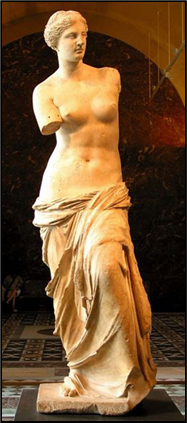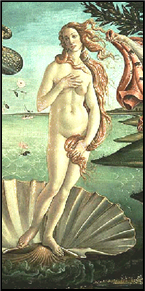


DISCOVERY OF THE VENUS DE MILO 1820 (G4)
xxxxxThe Venus de Milo, the famous piece of ancient Greek sculpture, was discovered on the Aegean Island of Melos in 1820. It was confiscated by the Turkish authorities, and bought by a French naval officer. It was presented to Louis XVIII the following year, and he donated it to the Louvre in Paris. This larger than life sculpture is thought to be the work of Alexandros of Antioch from around 130 BC, and to depict Aphrodite, the Greek goddess of love and beauty (known as Venus by the Romans).
 xxxxxOne of the most famous pieces of ancient Greek sculpture, the so-
xxxxxOne of the most famous pieces of ancient Greek sculpture, the so-
xxxxxThe origin of this exquisite piece of work in white parian marble is not certain, but this larger than life statue (about 6ft 8 inches in height) is thought to be the work of the sculptor Alexandros of Antioch and probably dates from around 130 BC. This belief is based on an inscription which was on the statue’s plinth, since lost. The figure was found without its arms, but lying nearby was a piece of a forearm and, more significantly, a left hand holding an apple. This is why the sculpture is generally believed to depict Aphrodite, the Greek goddess of love and beauty (known as Venus by the Romans) in the pose of Venus Victrix (Herald of Victory) -
xxxxxAs one might expect, many attempts were made to envisage what the statue originally looked like. Indeed, once in France a number of ideas were put forward to replace the missing arms and have Venus holding a shield, a lamp, an apple, or a mirror by which she could admire her own beauty. Eventually -
 xxxxxForxthe French, the acquisition of this treasured piece of ancient art was a much needed propaganda coup. Only five years earlier they had been obliged to return to the Italians the beautiful Medici Venus (illustrated), a classical sculpture which had been stolen from the Uffizi Gallery, Florence by Napoleon Bonaparte during his Italian campaign of 1802 and taken to Paris. In a face-
xxxxxForxthe French, the acquisition of this treasured piece of ancient art was a much needed propaganda coup. Only five years earlier they had been obliged to return to the Italians the beautiful Medici Venus (illustrated), a classical sculpture which had been stolen from the Uffizi Gallery, Florence by Napoleon Bonaparte during his Italian campaign of 1802 and taken to Paris. In a face-
xxxxxIncidentally, the Medici Venus - pose (known as the Venus pudica or Modest Venus) in the Birth of Venus, his famous work in which the goddess is shown emerging from the sea standing on a huge shell. (
pose (known as the Venus pudica or Modest Venus) in the Birth of Venus, his famous work in which the goddess is shown emerging from the sea standing on a huge shell. (
xxxxx…… The idea that Venus was born from out of the sea came from the more appropriate Greek name of Aphrodite. The word aphros means foam in Greek. ……
xxxxx…… Among the many who admired The Venus de Milo was the English poet Lord Byron. He devoted five stanzas of his work Childe Harold to describe it. However, it was not to everyone’s liking. The famous French artist and one-
Acknowledgement
Birth of Venus: detail, by the Italian painter Sandro Botticelli (c1445-
G4-


